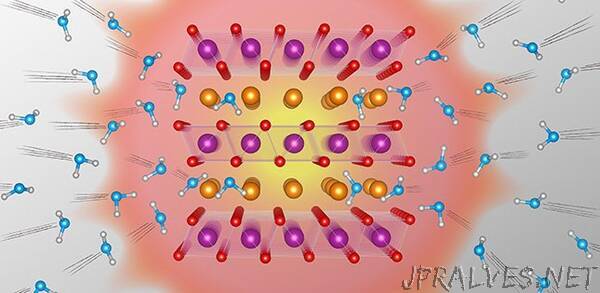
“Scientists in Japan have found a common substance that can reversibly and rapidly store and release relatively large amounts of low-grade heat without decomposing. The research could lead to more efficient reuse of industrial waste heat. The results were published in the journal Nature Communications and were a collaboration between scientists at Tohoku University’s Institute for Materials Research and Rigaku Corporation, a company that designs and manufactures X-ray-based measurement and thermal analysis tools.
In their investigations, the researchers used a layered manganese oxide mineral containing potassium ions and crystal water. This mineral is quite similar in its composition to birnessite, which is commonly found on the Earth’s surface. The team fabricated their compound in the form of an insoluble black powder and then examined its crystal structure using an X-ray diffractometer and a transmission electron microscope. They then examined how the compound’s structure changed when heated or cooled, and how much and how quickly heat energy was stored and released.
Heating the material up to 200︎°C dehydrated it by giving its stored water molecules the energy they need to be released into the surrounding atmosphere. When the dehydrated material was then cooled below 120︎°C in a dry container and then exposed to humid air, it absorbed water molecules and released its stored heat.
“This ‘intercalation’ mechanism, where water molecules are reversibly inserted into a layered material, is very advantageous for heat storage,” says Tohoku University materials scientist Tetsu Ichitsubo. “It is very fast, reversible and the material’s structure is well maintained. Also, oxygen in the atmosphere doesn’t degrade the layered manganese oxide crystal and water doesn’t dissolve it. This makes it an excellent candidate for waste-heat reuse in industrial settings.”
This ‘birnessite-type layered manganese dioxide with crystal water’ compound demonstrated better all-round performance compared to other compounds currently being researched for heat storage purposes. “Our material has a long lifetime, can reversibly store and release large amounts of heat per unit volume, and rapidly charges and discharges,” says Ichitsubo.
The researchers validated the results of their experiments with theoretical calculations.
Next, they plan to work on increasing the amount of water molecules that can be accommodated by the material in order to increase the amount of heat energy it can store per volume.”
